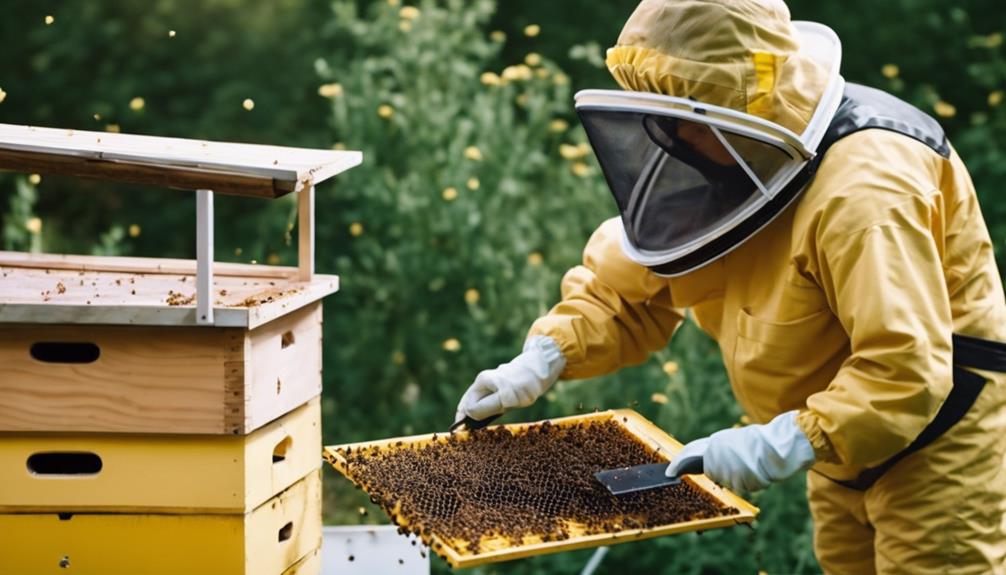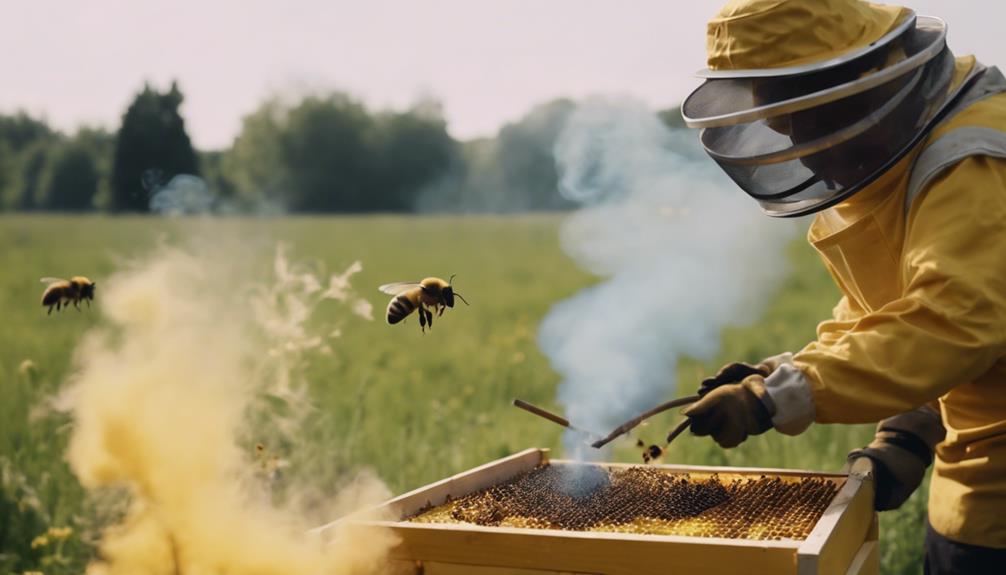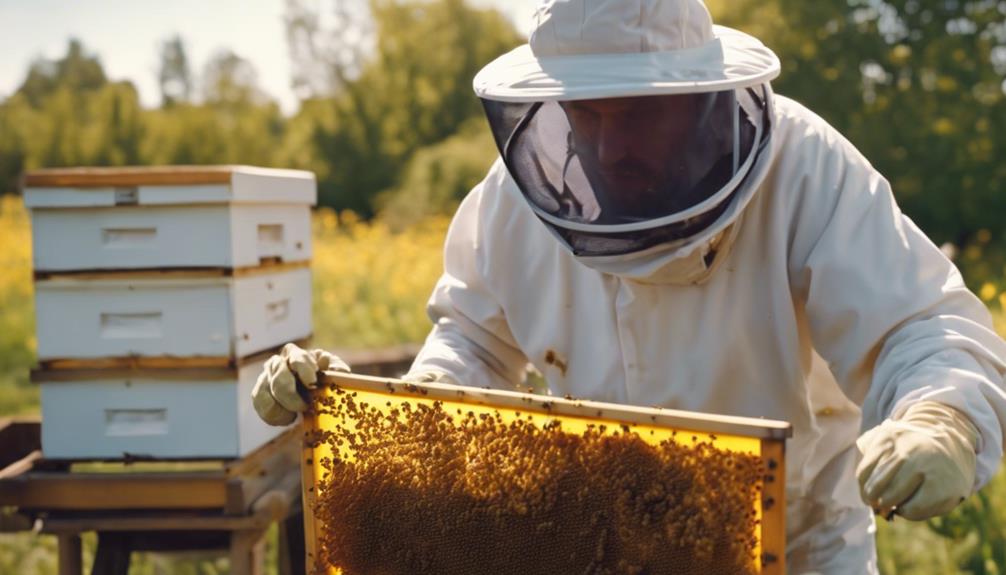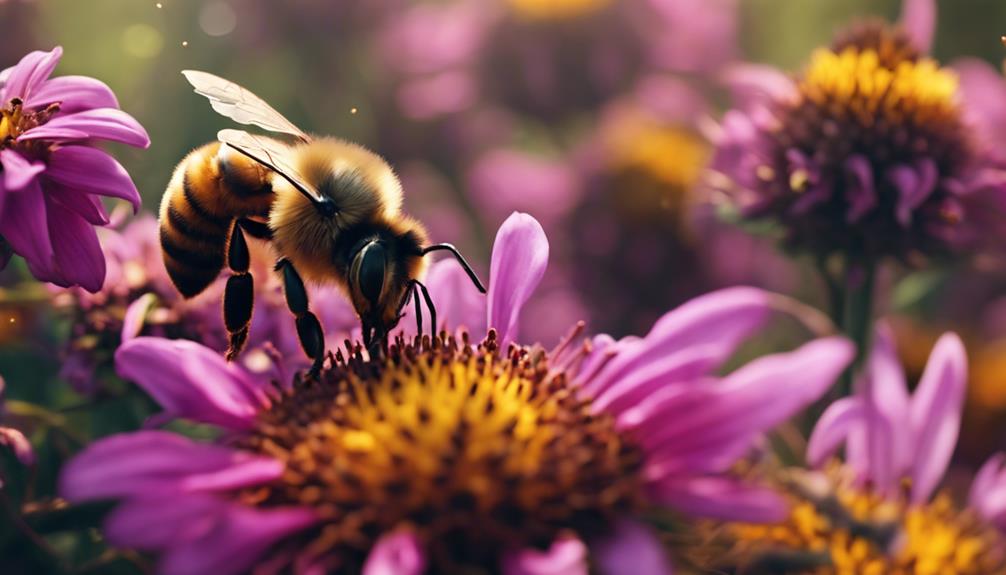Hey there! When fire smoke is around, bees don’t exactly disappear magically. The thing is, the smoke messes with their usual routines and chit-chats. Bees end up being less peppy and more chilled out during wildfires, affecting how they go about their daily business. Plus, all that smoky air messes with their ability to navigate and find food efficiently. It’s like their GPS is all wonky. But hey, there’s more to this bee-smoke story that might surprise you, so stick around!
Main Points
- Fire smoke disrupts bees’ behavior and foraging but doesn’t necessarily get rid of them.
- Bees may become docile due to smoke, impacting their activity levels and communication.
- Smoke is a temporary deterrent; bees use hive protection mechanisms to endure.
- Beekeepers use smoke to manage hives; complete bee removal requires alternative methods.
- Prioritize bee well-being, humane removal, and eco-friendly approaches for sustainable bee management.
Effects of Fire Smoke on Bees
When wildfires produce smoke, bees’ foraging patterns and behavior may be disrupted. The smoke can make it challenging for bees to navigate and locate flowers, affecting their ability to feed the bee colonies.
Beekeepers have noticed that during wildfires, bees become less active and tend to stay closer to the hive due to the presence of smoke. This change in behavior can impact the overall productivity of the bee colonies as bees may not be able to collect nectar and pollen as efficiently.
The sensitivity of bees to smoke leads to alterations in their usual activity levels and foraging habits, highlighting the intricate relationship between wildfires, smoke, and the well-being of bee populations.
Bee Behavior in Response to Smoke
When bees encounter smoke, they tend to become more subdued, almost as if the fumes have a calming effect on their frenetic buzz. This change in behavior can be attributed to the cooling effects of the smoke, which slow down their usual bustling activities.
Additionally, the disruption in communication caused by smoke can throw off the intricate dance of directions bees use to guide each other, impacting their ability to work efficiently as a cohesive unit.
Smoke and Bee Calming
Examining the impact of smoke on bee behavior reveals a notable calming effect, reducing their activity levels in cooler temperatures and fostering docile behavior during hive inspections.
- Bees pollinate efficiently when exposed to smoke, as it reduces their aggressive tendencies and allows beekeepers to work with them more safely.
- Smoke calms bees, making them less likely to sting and more cooperative during hive maintenance tasks.
- Atmospheric smoke alters bees’ foraging patterns, affecting their navigation and communication within the colony.
- Bees’ behavior changes in response to environmental factors like smoke, highlighting their adaptability to different conditions.
Impact on Bee Communication
Discussing the impact of smoke on bee communication reveals a significant disruption in their ability to navigate and coordinate tasks within the colony.
Honey bees heavily rely on communication signals like pheromones and dance to convey crucial information about food sources, potential threats, and hive locations. When smoke interferes with these signals, it creates chaos within the colony.
Bees may struggle to understand each other, leading to disorientation and inefficiency in completing their duties. This impaired communication can result in bees exhibiting erratic behavior and failing to work together harmoniously.
Ultimately, the disruption caused by smoke can throw off the social structure and organization within the hive, affecting the overall productivity and well-being of the bee community.
Beehive Protection Mechanism
In response to smoke, bees exhibit a unique defense mechanism by consuming honey and focusing on protecting their hive.
- Bees use honey production: When exposed to smoke, bees prioritize consuming honey to prepare for potential threats, such as fire or disturbances.
- Queen Bee’s role: The Queen Bee’s importance is vital, prompting the bees to safeguard her and the hive by intensifying their protective behaviors.
- Hive protection strategy: The disruption of communication signals due to smoke prompts bees to unite in defense of the colony, rather than focusing on individual actions.
- Beekeepers’ tool: Beekeepers use smoke to calm bees and trigger their innate response to shield the hive, making it easier to manage and interact with the colonies.
Bees’ instinctual behaviors and coordinated efforts ensure the hive’s safety in the face of potential threats.
Risks of Using Fire Smoke
When considering the risks of using fire smoke to eliminate bees, one must be cautious of the potential for accidental fires, such as igniting thatched houses. Not only can this method be hazardous, but it may also prove ineffective once bees start producing honeycomb. It’s vital to avoid using smoke in void spaces to prevent fire hazards and guarantee successful bee removal.
Using fire to create smoke for bee removal poses significant risks and safety concerns that shouldn’t be taken lightly. Remember, there are safer and more effective alternatives to smoking out bees, especially considering the risks involved.
Let’s investigate these alternatives further to find a method that works best for both us and the bees.
Alternatives to Fire Smoke for Bee Removal

Using bee repellents, relocating the hive, or seeking professional bee removal services are effective alternatives to fire smoke for bee removal. These methods offer a safe and humane approach to handling bee infestations without the risks associated with using fire smoke. Here are four alternatives to ponder:
- Bee Repellents: Natural repellents can deter bees from unwanted areas without causing harm.
- Relocating the Hive: By safely moving the hive to a more suitable location, you can protect both the bees and your property.
- Professional Removal Services: Experienced professionals can safely remove bees, ensuring the job is done efficiently and effectively.
- Eco-Friendly Approaches: Opt for environmentally friendly methods that prioritize the well-being of bees and the ecosystem.
Understanding Bee Reactions to Smoke
In regards to bees and smoke, it’s intriguing to observe how these small creatures respond in the presence of smoke.
From their heightened sensitivity to changes in behavior, bees demonstrate a distinct reaction to smoke.
Understanding the impact of smoke on bees can illuminate their intricate nature and the significance of this phenomenon.
Bee Sensitivity to Smoke
In the presence of smoke, bees exhibit a heightened sensitivity that significantly impacts their behavior. Here are four key points to ponder when understanding bee reactions to smoke:
- Bees are more sensitive to smoke than humans, affecting how they interact with their environment.
- Smoke can cause bees to become less active and change their foraging habits, potentially impacting the hive’s productivity.
- Beekeepers globally have noticed shifts in bee behavior due to various environmental factors, including exposure to smoke.
- Bees’ keen sense of smell likely plays a role in their response to atmospheric smoke during events such as wildfires. This heightened sensitivity raises concerns about the effects of smoke on bees’ well-being and honey reserves.
Behavioral Response to Smoke
During hive inspections, bees demonstrate docile behavior in response to smoke exposure. When smoke wafts through their home, bees tend to become calmer, making it easier for beekeepers to work with the hive. This reaction is a fascinating adaptation that helps protect the colony during potentially stressful situations.
Intriguingly, atmospheric smoke not only affects their behavior during inspections but also alters their foraging habits. Bees may become less active and show unusual behaviors like congregating on specific plants. This response to smoke is pivotal in understanding how bees navigate their environment and adapt to changing conditions.
The way bees react to environmental factors such as smoke sheds light on their resilience and ability to thrive in challenging circumstances.
Effects of Smoke
Understanding how smoke affects bees reveals important insights into their behavior and survival mechanisms.
Bees show subdued activity and become less active in cooler temperatures caused by smoke.
Smoke affects bees’ ability to navigate using polarized light, hampering their foraging behavior.
Ash from fires may interfere with bees’ breathing and physiology, impacting their survival.
Research indicates that smoke particles can have a negative impact on insect survival, including bees.
These facts highlight the intricate ways in which smoke disrupts bees’ normal functions and compromises their ability to thrive. By comprehending these effects, we gain a deeper understanding of the challenges bees face in the presence of smoke and the importance of protecting their delicate ecosystems.
Environmental Impact of Fire Smoke on Bees
Fire smoke’s impact on bees includes disrupting their ability to forage and navigate due to distorted light patterns. When atmospheric smoke fills the air, bees may appear less active, displaying unusual behaviors in response to the environmental changes.
The particles in the smoke could potentially affect the bees’ respiratory functions and overall survival. During wildfires, bees might exhibit docile behaviors or stay within the hive, avoiding the smoke-filled outdoors.
It’s intriguing how environmental factors like wildfire smoke can alter bees’ foraging habits and daily activities. As we explore the impact of fire smoke on bees, it becomes clear that these tiny creatures are intricately connected to their surroundings, responding sensitively to changes in the environment, including the presence of smoke.
Safety Precautions When Using Smoke

When using smoke to eradicate bees, it’s crucial to have a water source nearby and wear protective clothing to prevent bee stings. Here are some safety precautions to keep in mind:
- Have a water source: Always be prepared with water in case of emergencies.
- Wear protective clothing: Equip yourself with a bee suit and gloves for added safety.
- Ensure proper ventilation: Avoid inhaling harmful fumes by working in a well-ventilated area.
- Use a suitable smoker: Opt for a smoker designed for beekeeping to produce cool, white smoke effectively.
Following these precautions guarantees a safer bee removal process for both you and the bees. Stay safe and bee-free!
Limitations of Fire Smoke in Bee Control
Despite its traditional use in bee control, fire smoke presents notable limitations in effectively eradicating bee colonies. While it can be a quick fix, it may not guarantee the complete removal of bees, especially if the colony is well-established. Additionally, the use of fire smoke carries inherent risks, such as the potential for accidental fires, particularly in confined spaces.
Bees that have already built honeycombs mightn’t be deterred significantly by smoke, making this method less effective in such cases. Furthermore, once the smoke dissipates, there’s a chance of bees returning to the same location. Considering these drawbacks, it’s essential to investigate alternative, safer methods for bee control that minimize risks and ensure more sustainable solutions for managing bee populations.
Ethical Considerations in Bee Management

In considering ethical bee management, our focus shifts towards ensuring the well-being and preservation of bee colonies during removal processes. Here are four key considerations for ethical bee management:
- Prioritize the safety and preservation of bee colonies.
- Use humane methods to relocate bees instead of exterminating them.
- Consider the environmental impact and sustainability of bee management practices.
- Respect the natural behavior and habitat of bees.
It’s important to approach bee management with care and respect for these essential pollinators. By incorporating these ethical principles into our practices, we can help protect bee populations and contribute to a healthier ecosystem.

Hello! My name is Noel Calvin. I graduated from UCLA and now work as a writer at Launch Ninjas. I write blog posts that inspire and guide our readers in their entrepreneurial pursuits. I live in Pleasantville, NJ, with a peaceful yet lively atmosphere that inspires me.
Writing stories is more than just a job for me. It allows me to share my observations and satisfy my curiosity about the world. I combine my analytical skills with creative enthusiasm to delve into technology trends and startup stories. But my life isn’t limited to screens and keyboards. I value loyalty, passion, and a touch of old-fashioned charm, which I infuse into every narrative I create.
I love spending time in my garage, jamming with my band when I’m not writing. Playing the guitar and singing bring me immense joy. I also enjoy capturing ordinary and extraordinary moments through my camera lens and exploring new culinary adventures that excite my taste buds. I’m always seeking new experiences.
My family is very important to me. Joyful Sunday brunches filled with laughter and intense board game nights keep me grounded, reminding me of life’s simple pleasures.
In my world, every moment is an opportunity for discovery. Every discovery is a story worth sharing, whether a heartfelt moment at home or the pulse of technological innovations. Join me as I navigate through life, one blog post, one guitar strum, and one heartwarming family dinner at a time.


